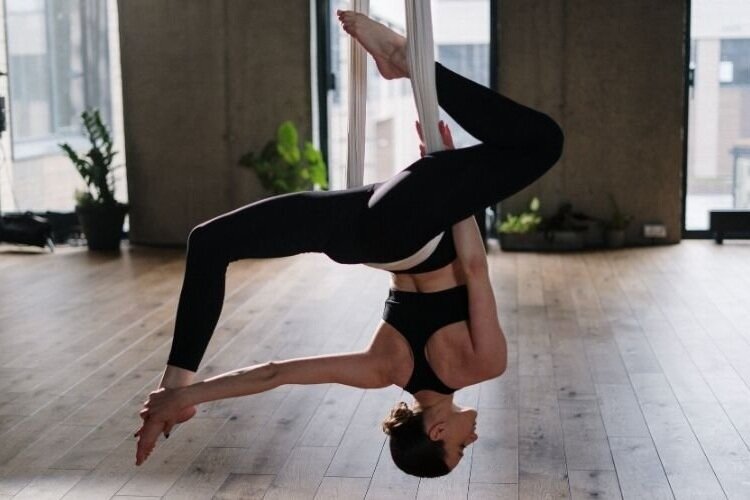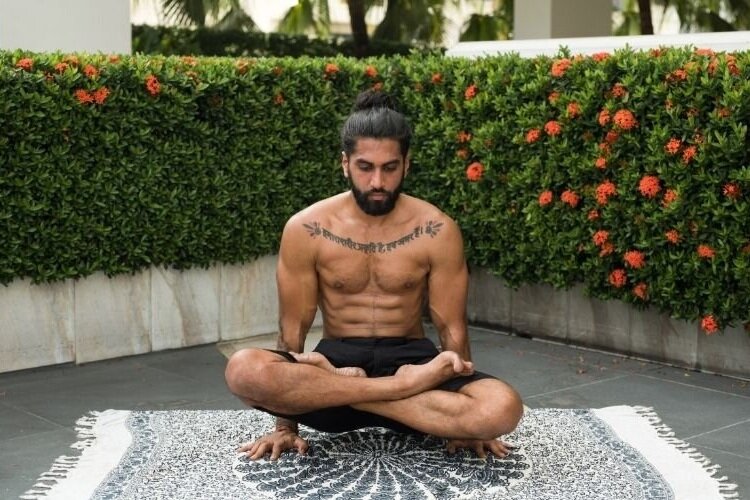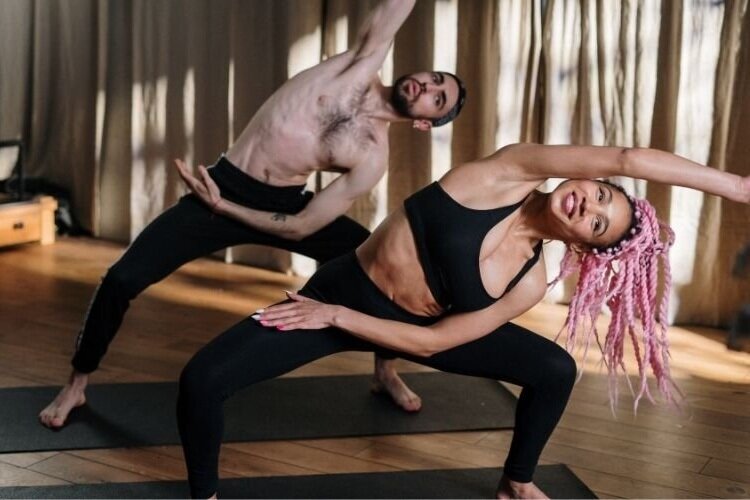What Style of Yoga Should I Practice?
Your guide to every style of yoga out there
Ok so you've finally decided you want to give yoga a try, but a quick search of classes has sent you running in the opposite direction. From Vinyasa to Iyengar, Yin to Ashtanga - what's the difference, and which one is right for you? There's so many different styles of yoga out there, but that also means there is a style of yoga for everyone! I'm here to help you make sense of each style, from the traditional to the more modern styles that are popping up.
Every teacher has their own personal way of teaching, so even though they may be teaching the same style of yoga, there could be interpretations and differences within the same style, especially for those types of yoga that don't have a strict order of poses. So if you don't connect with one teacher, I encourage you to give it another few tries. Just like there is a style of yoga for everyone, there is a yoga teacher for everyone!
Aerial / Antigravity Yoga
What is it?
A relatively new form of yoga where traditional poses are practiced with the support of a strong silky hammock hanging from the ceiling. Note that you'll be spending much of the class hanging upside down! The hammock helps you more easily perform inverted poses and is a great way to decompress your spine. Classes can either be challenging requiring strength to lift your own bodyweight, or relaxing and soothing.
Who is it for?
Anyone wanting to go upside down and try something different and fun.
Acro Yoga
What is it?
A combination of acrobatics and yoga with a partner. It involves a "base” on the ground who supports the "flyer”, the one in the air balancing on the soles of the base's feet. It is a super fun and playful form of yoga that improves strength and flexibility and requires a great deal of communication and trust between the partners.
Who is it for?
Couples, friends and anyone looking for non-traditional yoga in a fun and interactive environment.
Ashtanga / Mysore Yoga
What is it?
This is a fast-paced and challenging style of yoga where the same sequence is practised every time. The name Ashtanga Yoga originated in Patanjali's "Yoga Sutras", but it was Krishnamacharya and Pattabhi Jois who, in the 21st century, developed the style practised today. There are six series in total (Primary, Intermediate and four Advanced Series). Traditionally the way Ashtanga is taught is through the Mysore style. This is where the sequence is practised at your own pace and the teacher is in the room to provide individual guidance and support. When you first turn up to a Mysore class, the teacher will give you a set of asanas (postures) to learn and memorise. Once you show a level of proficiency, your teacher will add extra poses to your sequence until you have learned the entire Primary Series. Once you have mastered the Primary Series, you go through in the same way with the Intermediate Series, then the Advanced Series.
Who is it for?
Anyone who likes routine, structure and no surprises! The practice is the same every day and it often takes yogis years to progress to the next series. Expect to get sweaty and have your endurance, strength and flexibility challenged.
Baby Yoga and Massage
What is it?
Not as you might think, yoga with your baby, but rather yoga for your baby. Baby Massage is usually a precursor to Baby Yoga, where you massage your baby to improve circulation, promote digestion, relieve colic and teething symptoms. In Baby Yoga, you move your baby's body and limbs in a certain way to promote strength, co-ordination and development of motor skills such as rolling, crawling and sitting. Note that as the parent, you will be fully involved as well, helping your baby in different poses through various swings, holds, stretches and lifts. It's also a great way to bond with your baby, meet other parents and have baby playdates.
Who is it for?
Parents with babies older than 6 weeks. Baby Massage can start at any age, but you might like to wait until after 6 weeks to go to a class.
Bikram Yoga
What is it?
Bikram Yoga is a sequence of 26 postures and two breathing exercises practised in a 41 °C (105 °F) room with a humidity of 40%. The 90 minute sequence is always the same so you'll know exactly what to expect. You'll obviously also be sweating loads so make sure you hydrate properly and have a towel handy. Those new to Bikram Yoga can often feel light-headed, dizzy and possibly even nauseous the first few times.
Who is it for?
If you like predictability in your practice, hot temperatures and are looking to sweat, this is the practice for you!
Hatha Yoga
What is it?
Strictly speaking, all yoga is Hatha Yoga. "Hatha" in Sanskrit refers to the physical practice of asanas. But in the West, it's known as a slower and gentler form of yoga where you typically hold poses for a few breaths. It's a great form of yoga to build your foundations to go into more advanced styles of yoga or postures.
Who is it for?
Beginners and anyone looking to go back to foundations. Because of the slower pace, this class should be much easier to follow than a Vinyasa class. There may also be more focus placed on alignment and deep breathing.
Hot Yoga
What is it?
Hot Yoga is similar to Bikram in that it is practised in a heated room of 35 - 40 °C (95 - 105 °F). However there is no strict repeated sequence. Instead it is more like a Vinyasa Flow. The temperature is intended to loosen your muscles and cleanse your body through sweating. But be careful not to push too hard as the heat can make overstretching very easy. And like Bikram, make sure to hydrate and have a towel handy!
Who is it for?
People looking for a tough workout who like variety in their practice and who don't mind, and even like, getting sweaty.
Inside Flow
What is it?
This style of yoga was founded by Young Ho Kim and derives from Vinyasa Flow. It is one of the more modern styles to pop up in the recent years. Sequences are matched with modern day music to create a dance-like flow, moving as one between body, breath and music.
Who is it for?
Anyone who loves to move and practice with music, and who is not after a traditional yoga class.
Iyengar Yoga
What is it?
Iyengar Yoga was named after, and developed, by B. K. S. Iyengar. It rose to prominence in the 1960's when American and European students started seeking out yoga. Iyengar Yoga is all about precision, detail and alignment. There is a big emphasis on the correct and proper alignment in each pose, and that through consistent practice, each student will be able to reach the perfect position. Poses are held for longer periods of time and poses are almost always accompanied by props to support each student within their own range of motion. Props include yoga blocks, blankets, straps and ropes on a wall.
Who is it for?
Beginners and advanced alike, and anyone who is detail-oriented and likes to learn about anatomy and form.
Jivamukti Yoga
What is it?
Jivamukti Yoga was created in the 1980's by David Life and Shannon Gannon. It is a vigorous and physical form of yoga derived from Hatha Yoga and each class often involves music, chanting and scripture. The purpose of Jivamukti Yoga is to find liberation, self-realisation and a compassion for all living beings.
Who is it for?
Anyone looking for a strong physical practice combined with a more spiritual element delving deeper into the meaning of yoga and your own physical awareness.
Kundalini Yoga
What is it?
Kundalini Yoga combines asanas, pranayama (breathing exercises), meditation and chanting in a physically and mentally challenging practice. Kundalini sequences or kriyas as they are called, consist of repetitive physical exercises combined with intense breath work to awaken the energy residing at the base of your spine and move it upward through your seven chakras (energy centres within the body) in order to reach enlightenment. Kundalini Yoga can be a highly emotional and cathartic experience.
Who is it for?
Anyone looking for a more spiritual practice. Go with an open mind - you might be asked to dance, jump, shake, sing, shout to awaken the Kundalini energy. And in more traditional classes you may be asked to wear only white.
Postnatal Yoga
What is it?
A gentler practice with a strong focus on the pelvic floor to help mothers rebuild their bodies from the inside out after birth. Like with Prenatal Yoga, you could also attend a regular yoga class with modifications, but you won't get the specific attention you need for your body after birth. There are an array of things the body goes through after birth, so you'll want a teacher who is trained in knowing what movements are safe and what movements aren't. Some Postnatal Yoga classes allow you to bring your little one along so it can also be a great way to meet other mums and let the babies interact.
Who is it for?
Women who have given birth. Make sure you have completed your 6-week check with your doctor first and you have been given the ok to start exercising. And Postnatal Yoga is not just for your fourth trimester. You can continue doing it until you feel you're ready to move on.
Power Yoga
What is it?
Think cardio, strength, sweat and lots of movement! Power Yoga has evolved to become a term that encompasses many kinds of dynamic and vigorous yoga practices that are more fitness-based. The focus is on the body and building strength.
Who is it for?
Anyone looking for a full-body workout to tone and strengthen their body in a more athletic approach to yoga.
Prenatal Yoga
What is it?
Like the name suggests, this one is for expecting mamas. You could attend a regular yoga class with modifications, but if you are pregnant, it's best to attend a Prenatal Yoga class. Teachers will know which poses are safe and which poses to avoid to ensure you are practising safely through every trimester of your pregnancy. It's a great place to find a connection with your little one before they are born and to learn and practise breathing techniques that will surely help you through labour when the time comes.
Who is it for?
Pregnant women, usually from week 12 onwards.
Restorative Yoga
What is it?
Very similar to Yin Yoga in being another slow and passive form of yoga where poses are held for minutes at a time. Restorative Yoga is what the name suggests, it restores the body back to its most optimal functioning mode by tapping into the parasympathetic nervous system. A multitude of props are used to support the body in each pose and you'll spend the entire class on the floor. It is more gentle than Yin Yoga and poses are meant to be comfortable and relaxed instead of stressing the joints.
Who is it for?
If you're looking for a very calming practice, need to slow down, recover, or struggle with stress and anxiety, try out a Restorative Yoga class. It is also great if you have any injuries as the props will support you where you need.
Rocket Yoga
What is it?
Rocket Yoga is a dynamic and fast-paced style of yoga. It was developed by Larry Schultz in the 1980's and has its roots in the traditional Ashtanga Yoga series with the structure of the classes remaining quite similar - beginning with Sun Salutations A + B, standing poses, seated poses and ending with the traditional closing series. Students are encouraged to modify poses on their own as they need for their own bodies, making it less rigid than Ashtanga Yoga. There are three series - Rocket 1, Rocket 2 and Rocket 3. Rocket 1 is based on the Modified Primary Series, Rocket 2 on the Intermediate Series, and Rocket 3 is a combination of the two covering 90 poses in 90 minutes.
Who is it for?
You like a fast-paced, athletic and strong practice with structure but a little less rigidity. You'll be challenged in stamina, strength and flexibility.
Sivananda Yoga
What is it?
Sivananda Yoga comes from the lineage of Swami Sivananda and was brought to the west by his disciples in the 1950's. Till this day, it remains as one of the most traditional and authentic yogic practices based on classical Hatha Yoga. The Sivananda Method is based on 5 principles - Proper Exercise (asana), Proper Breathing (pranayama), Proper Relaxation (savasana), Proper Diet, and Positive Thinking (vedanta) and Meditation (dhyana). A class always follows the same structure of Pranayama, Sun Salutations, 12 basic poses in a specific order beginning with a Headstand, and ending with Savasana. The practice of Sivananda Yoga goes beyond the physical and is meant to promote physical, mental and spiritual well-being.
Who is it for?
Beginners, intermediate and advanced yogis looking to find a yoga practice that promotes an overall balanced well-being and to delve deeper into the yogic philosophy.
Vinyasa Yoga
What is it?
Vinyasa Yoga is all about fluid dance-like moves connecting and synchronising movement to breath. It is a dynamic and challenging practice moving at a quick pace. Sequences are creative and no two classes are the same, but it will mostly like include a series of Sun Salutations, Warrior poses, standing and seated postures and end with savasana.
Who is it for?
If you don't like to do the same sequence every time and are looking to tone up, build strength and increase flexibility, Vinyasa was made for you! Be prepared to move a lot, and break out a sweat.
Yin Yoga
What is it?
Yin Yoga is a very slow and passive form of yoga incorporating principles of Traditional Chinese Medicine. Poses are held for anywhere between 3 minutes and 7 minutes (advanced Yin Yogis may hold for even longer) and work deep into the connective tissues of the body, stimulating and removing any blockages along the meridians (energy channels in the body). It is practised cold (no warm up or sweaty workout before) and is a deeply meditative and reflective practice. The idea is to meet yourself as you are on your mat and to find comfort in mild discomfort. You'll spend most, if not all, of the time on the floor, and a range of props - from blocks, bolsters, straps and blankets - are used to support each position.
Who is it for?
Anyone who is looking for a slow, meditative practice and who needs to destress and unwind, or anyone who practices a lot of Yang exercises (think running, HIIT, CrossFit). It is also a great form of yoga to increase flexibility in a more holistic way.
—-
If you would like to try out some of these styles of yoga, I offer classes in many of these styles. You can find my schedule here. Or feel free to message me if you're looking for something specific. I am available to teach in person or online.
And if I missed out any style of yoga, let me know in the comments below and I'll be happy to add it to this list! So, what's your favourite style of yoga?



















